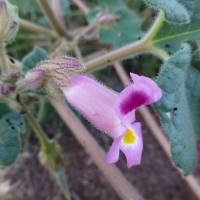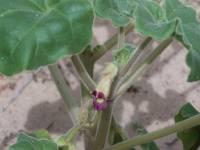PLANT: Erect to decumbent herbs arising from annual taproots or perennial tuberous roots.
LEAVES: orbicular-reniform to ovate-lanceolate, sometimes inequilateral at base with margins entire or palmately or pinnately lobed.
INFLORESCENCE: usually exceeding the leaves, few- to many-flowered, the axis lengthening in fruit.
FLOWERS: 2-7 cm in length; pedicels erect to spreading but lengthening, thickening and becoming deflexed in fruit; calyx up to 2.5 cm long, spathaceous and more or less unequally 5-lobed, split abaxially to the base, deciduous, with 2 frequently fleshythickened linear to orbicular bracts at the base; corolla sympetalous, somewhat bilabiate, tubular-cylindric to campanulate or infundibular, more or less gibbous and ventricose, the limb 5-lobed, the lobes rounded; stamens 4, didynamous, the rudiment of a 5th usually obvious, included in throat of corolla, the abaxial pair of fertile stamens longer; filaments arcuate; anthers gland-tipped with spreading cells; pistils about as long to longer than stamens; style slender, about three times as long as ovary; stigma lobes 2, sensitive, obovate-oblanceolate, included in or slightly exserted from the throat; ovary 1-celled, ovate to lanceolate and usually glabrous.
FRUIT: exocarp viscid-tomentose, deciduous; endocarp woody, reticulate-sculptured, with a suture on both dorsal and ventral median lines, crested along the dorsal suture and occasionally on the ventral suture, terminated by an upcurved beak about 1.25 to 3.5 times as long as the body that splits into two elongate, sharp-pointed rostrum.
SEEDS: black or white, 6-8 mm long, angled, with a thick corky tuberculate testa.
NOTES: 6 species; U.S., Mexico, Guatemala, Peru; may be naturalized as a weed worldwide. (Name from Greek, proboskis, pro- forward or in front of +boskein to feed, in allusion to the long-beaked fruit and its resemblance to elephants and their relatives.)
REFERENCES: Raul Gutierrez Jr., 2007, Vascular Plants of Arizona: Martyniaceae. CANOTIA 3 (2): 26-31.
Fr a 4-locellar drupaceous capsule, the exocarp fleshy, separating from the woody, reticulately sculptured, dehiscent endocarp, the thickened, seed-bearing portion crested on the upper (and sometimes also the lower) side, tapering into a long, stout, arcuately incurved beak that splits into 2 halves; cal irregular, cleft nearly to the base on the lower side; cor ventricose, weakly bilabiate; stamens 4; pollen- sacs widely divaricate, joined only at the summit; ovary initially unilocular, with 2 deeply intruded parietal placentas, each of these forked into 2 vertical lamellae, the ovules uniseriate along the edge of each lamella; herbs with a heavy odor; upper lvs often alternate; fls in terminal racemes that may appear lateral because of the continuing sympodial growth of the stem. 10, mostly N. Amer.
Gleason, Henry A. & Cronquist, Arthur J. 1991. Manual of vascular plants of northeastern United States and adjacent Canada. lxxv + 910 pp.
©The New York Botanical Garden. All rights reserved. Used by permission.







